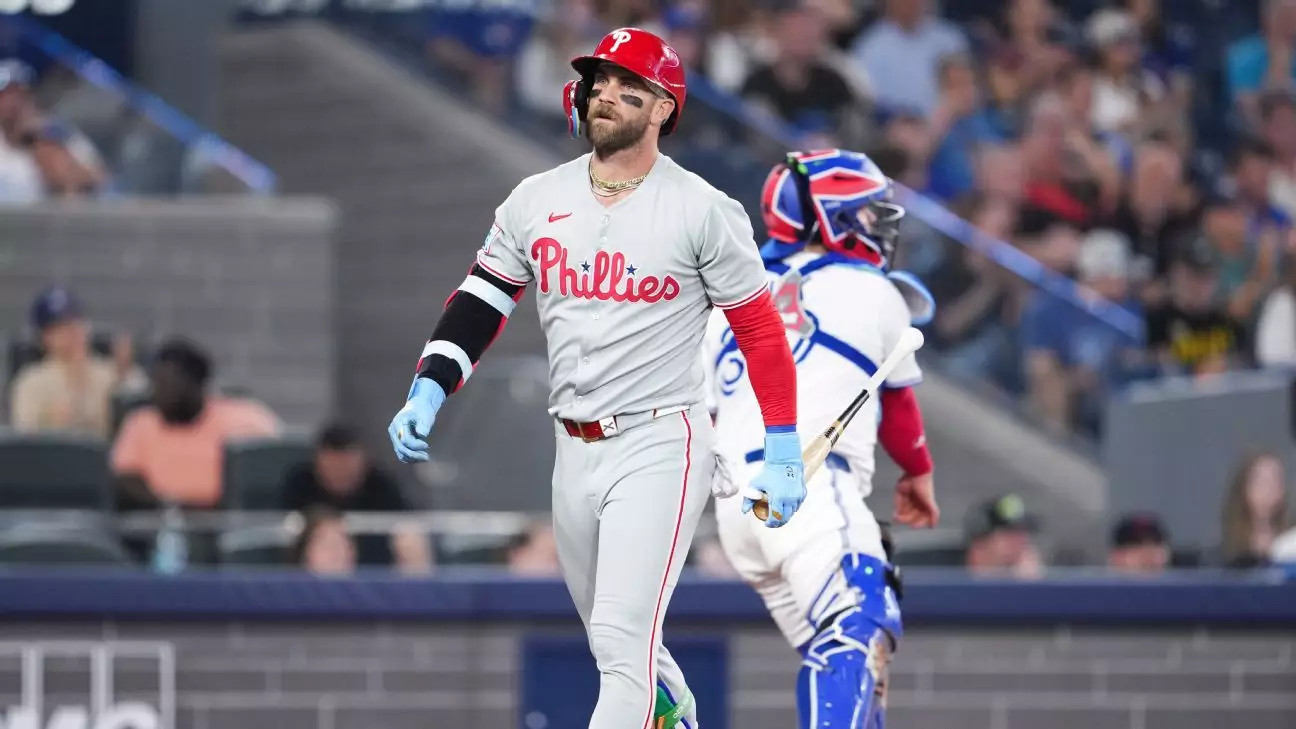Bryce Harper’s recent return to the Philadelphia Phillies after nearly a month sidelined by wrist inflammation is more than just a simple comeback—it’s a bold statement on resilience in professional sports. The star slugger’s right wrist had been troubling him for an extended period, dating back to last season, yet he demonstrated an admirable level of grit and determination by playing through constant discomfort. Harper’s choice to push forward, despite his injury, showcases the mentality that elite athletes often carry: to give their all for the team, even when their bodies protest.
Wrist injuries can be particularly detrimental for hitters, as the wrist serves as a critical pivot point for generating power and precision. Harper’s admission that he previously felt a consistent degree of pain while swinging or fielding reveals just how challenging it was for him to perform at his usual high level. It’s no surprise then that his offensive numbers took a hit in some respects. Still, he managed to contribute significantly during the season, a testament both to his skill and his mental toughness.
Impact on Team Dynamics and Lineup Adjustments
Harper’s absence underscored the Phillies’ need to adapt quickly, both offensively and defensively. The team struggled to a sub-.500 record (13-14) without him on the field, yet still maintained top position in the NL East—a notable feat that speaks to the depth and tenacity of the roster. To accommodate Harper’s return, the Phillies showed a willingness to make roster adjustments, such as designating infielder Buddy Kennedy for assignment. This move signals the team’s high confidence in Harper’s ability to contribute immediately and highlights the sometimes harsh realities of roster management in professional baseball.
The Phillies’ rookie, Otto Kemp, emerged admirably during Harper’s absence, showing promise as a multi-positional player. His versatility and production gave the team options, but Harper’s return inevitably shifts the lineup dynamic. The challenge for Harper and the coaching staff will be finding the best balance where Harper’s presence lifts the offense without stifling the growth of emerging talents like Kemp. Manager Rob Thomson’s cautious “day-to-day” approach to Harper’s wrist health indicates an awareness of the fine line between pushing a superstar and managing his long-term viability.
The Weight of Expectations and Legacy
Harper isn’t just any player. As a two-time National League MVP and eight-time All-Star locked into a massive $330 million contract, expectations run sky-high. His leadership has been integral to the Phillies’ recent playoff successes, including a spectacular 2022 postseason run that ended just short of a World Series championship. These achievements add layers of pressure in moments like these when his physical condition is in question.
One can’t ignore the psychological aspect of Harper’s situation. Playing while injured can complicate a player’s confidence and mechanic execution. Harper’s statement that he reached a “standstill” in feeling better shows that he was navigating a fine balance: the desire to return must be weighed against the reality that healing isn’t progressing. Opting for a cautious return rather than rushing back too quickly likely preserved his longer-term value.
Future Roles and Strategic Flexibility
While Harper started at first base upon his return, questions loom about his exact role moving forward. Kyle Schwarber’s success as a designated hitter opens a potential path for Harper to gradually manage his workload depending on the wrist’s response to daily play. This strategy wouldn’t just protect Harper but might also optimize the lineup’s overall firepower.
For Harper, the idea of embracing a transitional role might not be easy given his stature and competitive nature. However, adapting to different positions and diversifying his contributions could extend his effective career span. From a team perspective, managing Harper’s injury thoughtfully while maximizing his presence is a smart play—both competitively and economically.
Bryce Harper’s story this season is a vivid reminder that even superstars aren’t invincible. His return embodies a fighter’s mindset while forcing a team-level recalibration in strategy, lineup construction, and player utilization. This episode in his career should be viewed not merely as an injury comeback but as a broader symbol of adaptive leadership and tenacity in the face of physical adversity.

